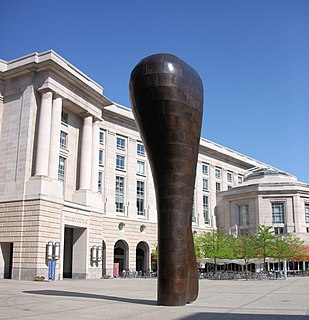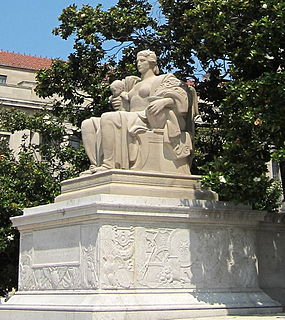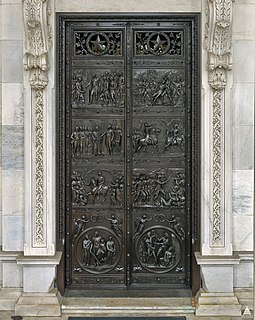
Washington, D.C., formally the District of Columbia, also known as just Washington or simply D.C., is the capital city and only federal district of the United States. It is located on the east bank of the Potomac River, which forms its southwestern and southern border with the U.S. state of Virginia, and it shares a land border with the U.S. state of Maryland on its remaining sides. The city was named for George Washington, a Founding Father and the first president of the United States, and the federal district is named after Columbia, a female personification of the nation. As the seat of the U.S. federal government and several international organizations, the city is an important world political capital. It is one of the most visited cities in the U.S., seeing over 20 million visitors in 2016.

John Russell Pope was an American architect whose firm is widely known for designing major public buildings, including the National Archives and Records Administration building, the Jefferson Memorial and the West Building of the National Gallery of Art, all in Washington, DC.

Hubert Durrett Stephens was an American politician who served as a Democratic United States Senator from Mississippi from 1923 until 1935.

James Earle Fraser was an American sculptor during the first half of the 20th century. His work is integral to many of Washington, D.C.'s most iconic structures.

Paul Philippe Cret was a French-born Philadelphia architect and industrial designer. For more than thirty years, he taught a design studio in the Department of Architecture at the University of Pennsylvania.

William Henry Holmes, known as W.H. Holmes, was an American explorer, anthropologist, archaeologist, artist, scientific illustrator, cartographer, mountain climber, geologist and museum curator and director.

The Revolutionary War Door is an artwork by American sculptor Thomas Crawford, located on the United States Capitol House of Representatives wing east front in Washington, D.C., United States. This sculptured door was surveyed in 1993 as part of the Smithsonian's Save Outdoor Sculpture! program.

Chief Justice John Marshall is a bronze sculpture of John Marshall, by American sculptor William Wetmore Story. It is located at the Supreme Court, 1 First Street, Northeast, Washington, D.C. It was dedicated on May 10, 1884, by Morrison Waite. It was relocated from the West Terrace, of the United States Capitol.

Past is a 1935 outdoor sculpture by Robert Ingersoll Aitken, located in front of the National Archives Building in Washington, D.C., in the United States. John Russell Pope served as the sculpture's architect and Edward H. Ratti served as its carver. The sculpture is made of Indiana limestone and measures approximately 20 x 8 x 12 feet, with a base approximately 12 x 12 x 15 feet. Past is a companion piece to Present, also located in front of the National Archives Building.

Present, also known as Future, is a 1935 outdoor sculpture by Robert Ingersoll Aitken, located in front of the National Archives Building in Washington, D.C., in the United States. John Russell Pope served as the sculpture's architect and Edward H. Ratti served as its carver. The sculpture is made of Indiana limestone and measures approximately 20 x 8 x 12 feet, with a base approximately 12 x 12 x 15 feet. Present is a companion piece to Past, also located in front of the National Archives Building.

George Washington is a series of outdoor bronze busts depicting George Washington by Avard Fairbanks, located on the George Washington University campus in Washington, D.C.

Bearing Witness is an outdoor 1997 sculpture by Martin Puryear, installed outside the Ronald Reagan Building and International Trade Center in Washington, D.C., in the United States.

Heritage is an outdoor 1935 sculpture by American artist James Earle Fraser, installed in front of the National Archives Building in Washington, D.C., United States. Heritage is a companion piece to Guardianship.

Buffalo, also known as Buffaloes, Dumbarton Bridge: Buffaloes, and Q Street Buffalo, is a series of monumental sculptures of buffalo by Alexander Phimister Proctor. Four of them are installed at the Dumbarton Bridge in Washington, D.C., in the United States.

Queen Isabella, also known as Queen Isabella (1451–1504), is an outdoor sculpture of Isabella I of Castile, installed outside the Pan American Union Building of the Organization of American States at 17th Street and Constitution Avenue NW in Washington, D.C., in the United States.

An outdoor sculpture of Nelson Mandela by Jean Doyle is installed outside the Embassy of South Africa, Washington, D.C., in the United States. The 9-foot (2.7 m) statue was unveiled on September 21, 2013.

Hannibal Hamlin is a bronze sculpture depicting the American attorney and politician of the same name by Charles Tefft, installed at the United States Capitol's National Statuary Hall, in Washington, D.C., as part of the National Statuary Hall Collection. The statue was gifted by the U.S. state of Maine in 1935.
Huey Long is a 1941 bronze sculpture of Huey Long by Charles Keck, installed in the United States Capitol, in Washington, D.C., as part of the National Statuary Hall Collection. It is one of two statues donated by the state of Louisiana.

United States gubernatorial elections were held in 1935, in three states. Kentucky, Louisiana and Mississippi hold their gubernatorial elections in odd numbered years, every 4 years, preceding the United States presidential election year.

The George Washington and the Revolutionary War Door (1855–1868) is pair of a bronze sculptured doors to the Senate wing of the United States Capitol in Washington, D.C., United States. American sculptor Thomas Crawford designed and modeled the doors in the mid-1850s, but died prior to their completion. American sculptor William H. Rinehart completed the doors based on Crawford's designs.




















